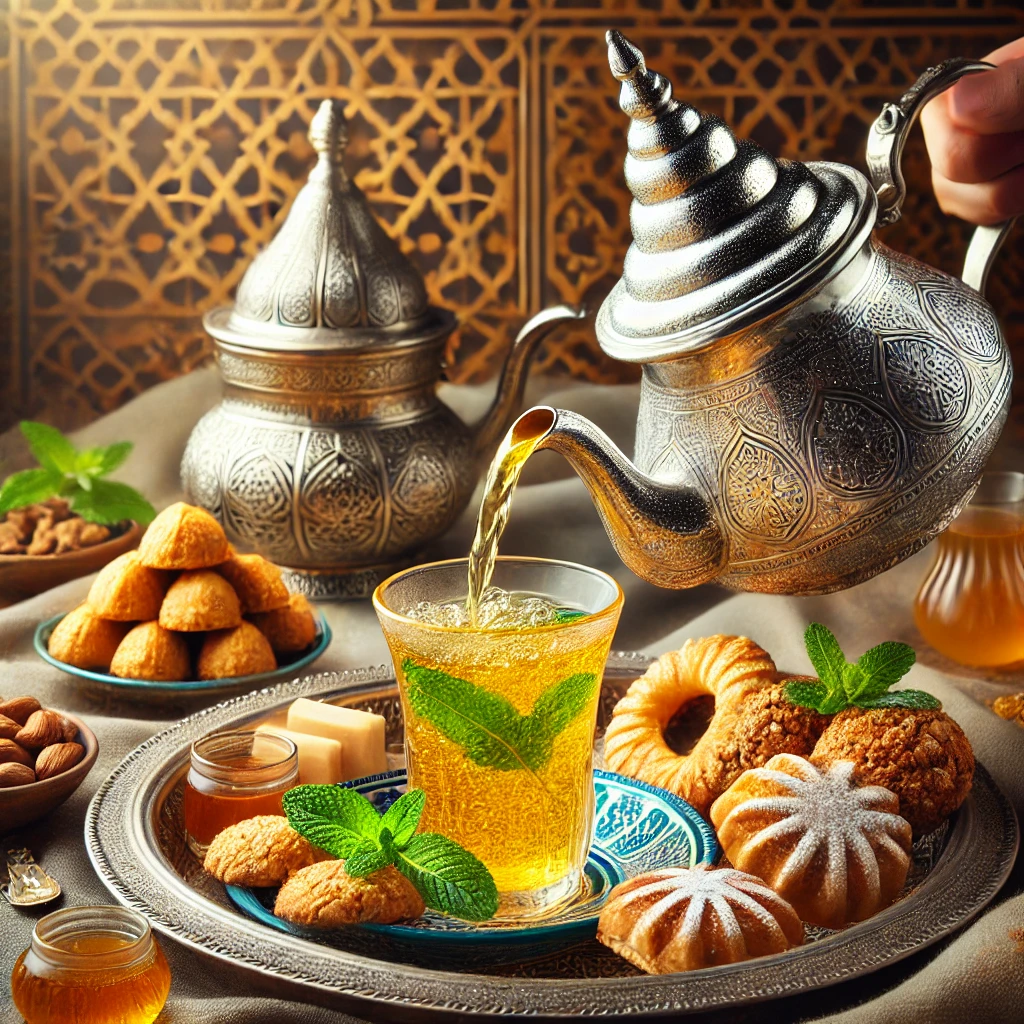Moroccan mint tea, known locally as “Atay,” is more than just a drink—it’s a symbol of warmth, hospitality, and tradition in Morocco. Often served alongside a delectable array of traditional sweets, it provides a sensory experience that is both refreshing and deeply rooted in Moroccan culture. In this article, we’ll delve into the history, preparation, and cultural significance of Moroccan mint tea and explore some popular sweets that perfectly complement this cherished beverage.
The Cultural Significance of Moroccan Mint Tea
Mint tea is ubiquitous in Moroccan households, cafes, and gatherings. It’s not only a drink to be enjoyed at mealtime, but a ritualistic offering that symbolizes friendship and respect. When you visit a Moroccan home, you’re almost always greeted with a steaming pot of mint tea—served in elegant, intricately designed glasses. Refusing this offer might be seen as impolite, as sharing tea is considered a gesture of goodwill and hospitality.
This cherished tradition extends beyond the home. In marketplaces, souks, and even the most remote areas of the country, you’ll find tea being prepared and served with great care. For Moroccans, it’s more than just a drink; it’s a social experience that brings people together.
The Origins of Moroccan Mint Tea
The origins of Moroccan mint tea are subject to historical debate. Some believe it was introduced by the Phoenicians, while others credit the Arab merchants who traveled through North Africa. However, it wasn’t until the 19th century, during the Crimean War, that tea became a staple in Morocco. British merchants, unable to sell their tea to the warring nations of Europe, found a market in Morocco. The Moroccans infused the tea with mint, a native herb, creating the unique blend that we know and love today.
How to Make Authentic Moroccan Mint Tea
Ingredients:
- Gunpowder Green Tea: 1 tablespoon (the base tea used for Moroccan mint tea)
- Fresh Mint Leaves: 1 large bunch (preferably spearmint)
- Sugar: 3 to 4 tablespoons (or to taste)
- Boiling Water: 1 liter
Preparation:
- Rinse the Tea: Start by adding a tablespoon of gunpowder green tea into a teapot. Pour in a small amount of boiling water, swirl it around to rinse the tea leaves, and discard this first water. This step helps remove any bitterness.
- Brew the Tea: Add fresh boiling water to the teapot and let the tea steep for a couple of minutes.
- Infuse with Mint: Add a generous handful of fresh mint leaves directly into the teapot. Stir gently to mix the flavors.
- Sweeten the Tea: Traditionally, Moroccan mint tea is sweetened with a large amount of sugar. Add 3 to 4 tablespoons of sugar (or according to your preference) and stir until dissolved.
- Aerate the Tea: Pour the tea into a glass and then back into the pot several times. This aeration technique enhances the flavors and produces a delicate layer of foam on top.
- Serve with Style: Pour the tea from a height into small, decorated glasses, creating bubbles on the surface.
Sweets That Pair Perfectly with Moroccan Mint Tea
Moroccan mint tea is often accompanied by an assortment of traditional sweets. The combination of sweet and refreshing flavors elevates the tea-drinking experience and highlights the richness of Moroccan cuisine. Here are a few popular sweets that pair wonderfully with mint tea:
1. Chebakia
Chebakia is a deep-fried cookie made from dough flavored with anise, sesame seeds, and orange blossom water, then shaped into intricate patterns. It’s fried to a golden brown and drenched in honey. The crunchy, sweet, and aromatic flavors make it an ideal accompaniment to the minty freshness of the tea.
2. Kaab El Ghazal (Gazelle Horns)
Kaab El Ghazal is a crescent-shaped pastry filled with almond paste, cinnamon, and orange blossom water. Its delicate, nutty sweetness is a perfect match for the robust and fragrant mint tea. Each bite delivers a rich, buttery texture that pairs seamlessly with the tea’s lightness.
3. Sellou
Sellou, also known as Sfouf, is a crumbly, dense sweet made from roasted flour, almonds, sesame seeds, and honey. It’s typically prepared during Ramadan and other festive occasions. The combination of roasted nuts and earthy flavors provides a rich contrast to the fresh, minty tea.
4. Ghriba
Ghriba is a melt-in-your-mouth cookie made from almond, sesame, or coconut flour. It’s often topped with a sprinkling of powdered sugar. The crumbly texture and mildly sweet flavor make it an excellent snack to enjoy with a glass of tea.
Health Benefits of Moroccan Mint Tea
Moroccan mint tea offers numerous health benefits. The primary ingredient, green tea, is rich in antioxidants and known to promote heart health, aid in digestion, and help regulate blood sugar levels. Mint, on the other hand, has natural calming and digestive properties. Together, these ingredients form a soothing, refreshing drink that not only tastes delicious but also supports overall well-being.
Conclusion
Moroccan mint tea with sweets is more than just a treat for the taste buds; it’s a celebration of Moroccan culture and tradition. Whether enjoyed in the comfort of your home or served at a special gathering, this combination reflects the spirit of hospitality and the rich culinary heritage of Morocco. So the next time you brew a pot of mint tea, consider serving it with some traditional Moroccan sweets to experience this delightful pairing in its full authenticity.
By understanding the history, preparation, and cultural significance of Moroccan mint tea, you’re not only enjoying a delicious drink but also becoming a part of a tradition that has been cherished for centuries.

